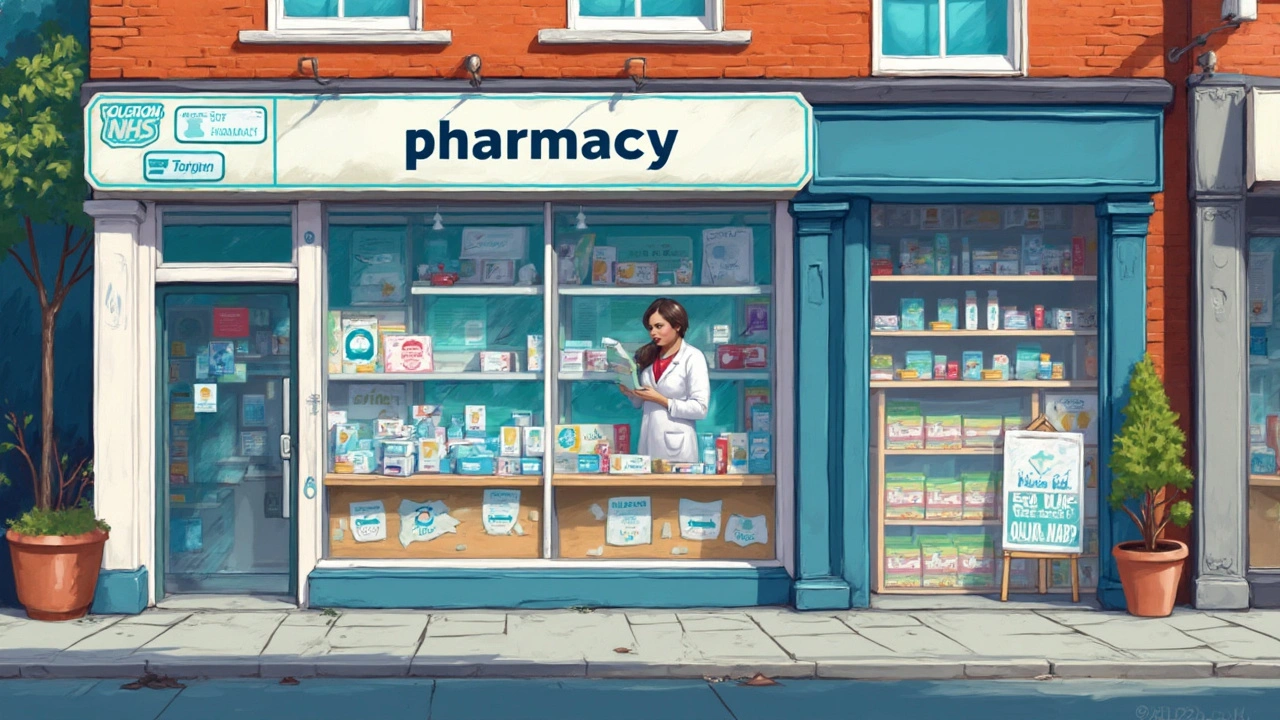If you’ve ever thought twice before ordering medicine online, you aren’t alone. The number of dodgy pharmacy sites is jaw-dropping: the National Association of Boards of Pharmacy checked thousands and found that over 95% failed their safety standards. Some of these websites look spotless, others sloppy—either way, the risks are real. We’re talking fake meds, missing shipments, stolen credit cards, and even sensitive info getting peddled to data brokers. It pays to be skeptical before you click 'buy now.' And no, those flashy badges and seals on sketchy websites don’t always mean a thing. There’s a smarter way to shop online—one that keeps your health, wallet, and data safe.
What Makes an Online Pharmacy Trustworthy?
First off, legit online pharmacies operate almost like your local chemist. They require a real prescription from a licensed doctor. Think about it: would you trust a brick-and-mortar pharmacy that hands out meds just for asking? Unlikely. If a pharmacy is offering prescription drugs without asking for your prescription, that's an immediate red flag. Reliable sites also have licensed pharmacists available for questions. Before you even look at their contact info, scan for things that should be obvious—like a physical address, a phone number you can call, and clear information about who owns the website.
Check the pharmacy's privacy policy too. A real pharmacy will spell out how they handle your personal data, protecting you from prying eyes or hidden third parties collecting your info. Watch out for ‘mirror’ sites: scammers often copy the look and logos of well-known pharmacies to fool you. If a website seems familiar but something’s a little off—maybe the name is slightly misspelled, or the design looks dated—stop before putting in your details. Websites that force you to pay only with cryptocurrency or wire transfer are another big warning. Real pharmacies offer familiar payment options and often work with health insurance.
Remember, drugs from questionable outlets might come from strange places. Pills could be expired, contaminated, or entirely different from what’s listed. The World Health Organization says up to 50% of medicines sold online from illegal sites are fake. Some might have no active ingredients or dangerously high doses. That's why you need proof a pharmacy is legitimate.
How to Use CIPA and NABP to Double-Check Online Pharmacies
Two heavyweights step in here: CIPA (the Canadian International Pharmacy Association) and NABP (the National Association of Boards of Pharmacy) in the US. CIPA is your go-to for Canadian websites, which lots of folks turn to for cheaper meds. NABP, meanwhile, keeps an eye on US and global players. Both have easy online tools to verify pharmacies—think of them as pharmacy bouncer lists.
- CIPA Verification: Head to the CIPA official site. There, you’ll find a directory of certified pharmacies. These aren’t just self-selected; CIPA checks each site’s license, safe shipping practices, and patient data handling. If a pharmacy claims to be 'CIPA approved' but isn’t on the official list, dodge it. Use CIPA's direct search with the site’s name, so you’re sure you're checking the real thing, not a lookalike.
- NABP Verification: NABP runs two main tools: the .Pharmacy Verified Sites Program and the Not Recommended List. For the first, you can search their site by entering a web address to see if it’s certified. NABP also provides a public list of 'not recommended' online pharmacies that failed checks or are linked to illegal activity. You can use their website like a blacklist—if your pharmacy's listed there, steer clear. Many legit pharmacies now use the .pharmacy domain, like www.onlinepharmacy.pharmacy, so look out for that too.
- If you’re looking for a safe alternative to Canadapharmacy, make sure the options you pick are backed by one of these organizations. It’s easy to fall for a pretty logo, but those don’t guarantee anything if they’re not verifiable through CIPA or NABP’s directories.
Quick tip: Don’t just check once. Scammers rebrand and relaunch all the time. Bookmark the lists and check back before making repeat purchases, especially if you see a price drop or a site redesign. It’s way less hassle than dealing with fake meds and credit card headaches.

Spotting Red Flags and Common Scams
Here’s where a little detective work pays off. There’s some wild stuff out there—sites hawk 'miracle cures,' 'no prescription necessary' antibiotics, and so-called ‘imported generics’ at a fraction of the standard price. These scams prey on people desperate for a deal or something their doctor won’t prescribe. If you stumble on a pharmacy promising drugs banned in New Zealand or the US, or offering bulk packs of opioids, abort mission. That’s not just shady; it could land you in legal trouble.
Emails promising miracle discounts, or pop-up ads with weird domain names, are classic phishing attempts. Sometimes the difference between a legal and a scam pharmacy is one letter—like onlinepharmacy.com (real) versus onlinepharmaccy.com (fake). Check the spelling, the URLs, and avoid clicking on offers from unsolicited emails. Look closely at the site’s design. Broken English, sloppy layouts, or generic drug lists are giveaways of a rush job meant to grab your cash and vanish.
Social media is crawling with fake pharmacy links, especially in comment sections and chat groups. Don’t trust a pharmacy just because a stranger in a Facebook group recommends it. They might be running a bot attack or paid promo. If you can’t find a real company address or pharmacist contact, or the ‘About’ page barely says anything, treat that as proof you should walk away.
Legal pharmacies should also have a license visible on their website. In the US, you can double-check these with your local state board. For Kiwis, stick to pharmacies registered with the Pharmacy Council of New Zealand. Different countries have their own licensing systems, but the principle is the same—if there’s no license or the registration number doesn’t match up, keep looking. Never trust a site that tries to rush you into buying with countdown timers or claims of 'limited stock.' That’s straight out of the scammer playbook. Want to be sure? Grab a screenshot, note the suspicious details, and Google them along with 'scam.' You’ll be amazed how often others have spotted the same tricks.
Smart Tips to Protect Yourself When Buying Medications Online
It can be tempting to focus on the price. But safety is worth more than a few dollars saved. Start with these basics: always use strong passwords, avoid saving your payment info online, and shop from secure sites (look for the https:// prefix and a padlock in your browser). Scroll to the bottom of pharmacy websites. Scam operations rarely bother with pages like 'Terms of Service,' 'Refund Policy,' or detailed FAQs. Real businesses invest in those details. Compare drug prices across a few legit sites using the verified lists—sometimes, huge discounts aren’t a deal; they’re bait.
Read the labels and packaging shown on the website photos. Real pharmacies will use genuine pictures, not AI mockups or random stock shots of pills. If your order arrives and the packaging is unmarked, or looks dodgy, snap a picture and contact the pharmacy right away. Don’t take the medicine until you confirm it’s authentic. Stick to known brands and avoid ‘research chemicals’ unless you know exactly what you’re getting. When in doubt, ask your local GP or a pharmacist. They deal with patients getting caught by scams more often than you think and can point you toward **online pharmacy verification** tools that match your needs.
If a medication is suddenly unavailable, don’t panic and jump at the first replacement you see online. Scammers capitalize on shortages by creating websites overnight. Slow down, double-check with CIPA or NABP, and look for that approved pharmacy badge that can be confirmed independently. If that sounds like a hassle, weigh it against the risk of ending up with sugar pills—or worse. Save the approved pharmacies you’ve checked to your phone or browser, so you aren’t scrambling next time you need a repeat prescription.
Lastly, trust your gut. If something on a pharmacy website feels 'off,' listen to that instinct. Weird delivery times, pressure to buy in bulk, or pushy upsell tactics don’t belong in any reputable medical setting. Check reviews, not just on the pharmacy’s own site, but third-party sources like Trustpilot. Remember: when it comes to your health, it’s worth taking that extra step. Safe shopping isn’t just about saving money; it could save your life.

katerine rose
May 26, 2025 AT 21:34Selma Cey
May 27, 2025 AT 03:46Francis Pascoe
May 27, 2025 AT 23:32Richa Shukla
May 29, 2025 AT 22:28Chris Rowe
May 30, 2025 AT 00:20Sushmita S
May 30, 2025 AT 21:54AnneMarie Carroll
May 31, 2025 AT 00:18John K
May 31, 2025 AT 14:20Laura Anderson
June 1, 2025 AT 00:05